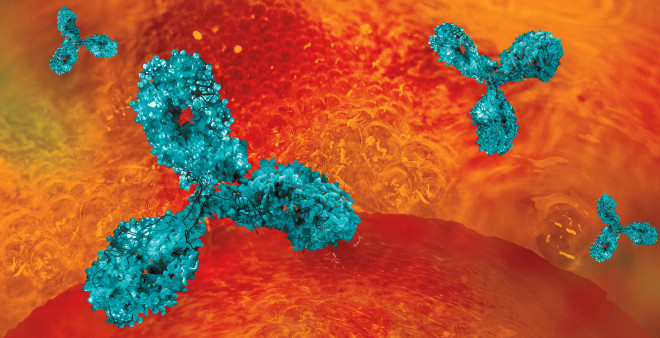Broadly neutralizing antibodies (bnAbs), which recognize multiple strains of HIV, show promise as a treatment for children when used in combination with standard antiretroviral therapy, according to research published in Science Translational Medicine.
The study found that two bnAbs, dubbed VRC01LS and 10-1074, prolonged viral suppression after stopping antiretrovirals, and they may have the potential to shrink the HIV reservoir and bring about long-term viral remission, especially in those who start treatment early.
Antiretroviral treatment can keep HIV replication suppressed as long as treatment continues, but the virus inserts its genetic blueprints (known as a provirus) into the DNA of human cells and establishes a long-lasting reservoir that is unreachable by antiretrovirals and invisible to the immune system. People with HIV normally produce HIV-specific antibodies, but these mostly target parts of the virus that are highly variable, so they don’t recognize new mutations. However, a small proportion of people make broadly neutralizing antibodies that target parts of the virus that don’t change much as it evolves. These potent antibodies could potentially be used for HIV pre-exposure prophylaxis (PrEP) and treatment that leads to a functional cure.
Roger Shapiro, MD, of Harvard T.H. Chan School of Public Health, and colleagues conducted a prospective clinical trial of dual bnAb treatment for children with HIV in Botswana. The study, called Tatelo, is the first to test bnAbs as an HIV treatment for children. Results were presented in part at the 2022 Conference on Retroviruses and Opportunistic Infections.
The 28 children, ages 2 to 6 years, had started standard oral antiretroviral therapy containing lopinavir/ritonavir (Kaletra) within the first week of life, continued on treatment for at least two years and had an undetectable viral load at study entry. They received VRC01LS and 10-1074 by intravenous infusion once monthly. VRC01LS is a long-acting version of VRC01—an antibody from a person who naturally controlled HIV—which targets the CD4-binding site on HIV’s gp120 envelope protein, while 10-1074 binds to the V3 loop.
Antibody treatment overlapped with antiretroviral therapy for at least eight weeks. Three of the children experienced viral rebound during the combination treatment period. The remaining 25 children who still had an undetectable viral load stopped their antiretrovirals and continued to receive the two bnAbs alone for up to six months or until they experienced viral rebound (above 400 copies).
Eleven of these 25 children (44%) maintained viral suppression for six months using the bnAbs alone, while 14 (56%) experienced viral rebound at a median of four weeks after discontinuing antiretrovirals. All were able to achieve viral suppression again after resuming antiretrovirals, but in some cases, this took a few months.
Children who had a smaller proviral HIV DNA reservoir in peripheral blood cells at the time of birth, had proviral HIV that was susceptible to 10-1074, had sustained viral suppression throughout early life and tested negative for both HIV DNA and HIV antibodies at study entry were more likely to maintain viral suppression after stopping antiretrovirals.
Treatment was generally safe and well tolerated, with no infusion reactions or bnAb-related severe adverse events. Some parents said they preferred monthly infusions rather than giving their children oral antiretrovirals every day.
“This proof-of-concept study suggests that bnAbs may represent a promising treatment modality for infants and children living with HIV-1,” the study authors concluded. “Future studies using newer bnAb combinations with greater breadth and potency are warranted.”
Research has also shown that bnAbs hold promise for adults with HIV. In one study, 13 out of 17 participants (76%) who discontinued antiretrovirals after their first infusions of 10-1074 and another antibody dubbed 3BNC117 maintained viral suppression for at least five months, and two of them did so for a year. This approach appears to work even better for people who start antiretroviral treatment early, like the children in the Tatelo study.
Click here for more news about broadly neutralizing antibodies.
Click here for more news about children and HIV.







Comments
Comments